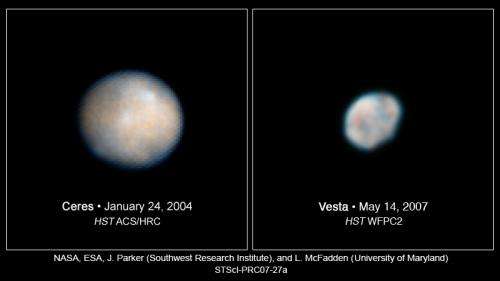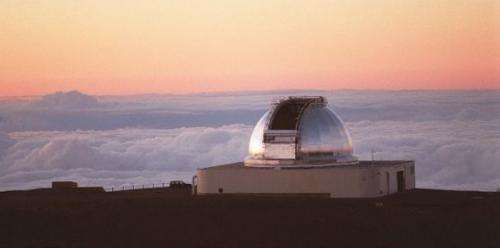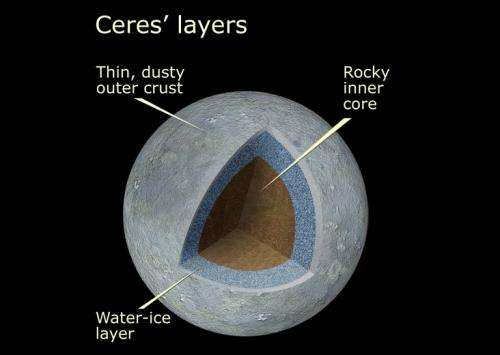Ice on Ceres: 'An Interesting Paradox'

As NASA's Dawn mission draws closer to its encounter with the dwarf planet Ceres in early 2015, excitement continues to mount for scientists looking forward to what the satellite might observe. Britney Schmidt, of the George Institute of Technology, and Nicole Gugliucci of CosmoQuest, recently hosted a Google+ Hangout titled 'Ceres: Great Expectations' to discuss the upcoming visit to the nearest dwarf planet in the solar system.
Orbiting in the asteroid belt, a little more than three times as far from the Sun as Earth, Ceres is thought to contain an icy mantle that makes up approximately a third of its mass.
"Ceres is very different and very exciting in a lot of ways, totally different from any place that we've been," Schmidt said in the broadcast. "It may be the only primarily icy planet that's out there, at least within reach."
Scratching the surface
Seen through a telescope, Ceres may not appear very exciting. Scientists can use the light reflected off of a body to find out information about its composition.
"Ceres, to the eye, would appear basically pretty black because it's reflecting most colors more or less the same, and reflecting very little light at all," said Andy Rivkin of the Johns Hopkins University Applied Physics Lab.
Even the infrared spectrum, which tends to reveal more information about asteroids such as Vesta—Dawn's first stop—provided very little information about its composition. By utilizing instruments such as the SpeX instrument on the NASA Infrared Telescope Facility (IRTF) on Mauna Kea in Hawaii, scientists were able to catch hints about the dwarf planet's surface.
These observations revealed suggestions of brucite, hydroxyls, and two other features Rivkin says are thought to be due to carbonate minerals.
"[This] makes Ceres one of only a few places where we've found carbonates," Rivkin said. "I think other than Earth and Mars, it's Ceres."
He went on to explain that scientists think water interacting with the minerals formed the brucite and the carbonates.
"For Ceres, we think it is much more consistent with a body that had a lot of water available to interact with."
But water, considered a potential habitat for life to start, can't exist on the surface of the dwarf planet in either solid or liquid form.
"We see no real evidence for ice at the surface of Ceres," Rivkin said, noting that the dwarf planet is too warm. "However, conditions beneath Ceres' surface should allow buried ice to remain there."

At the same time, observations from the Hubble Space Telescope, as well as theoretical data such as the planet's density, suggest that a large amount of ice exists.
"That creates this interesting paradox. We think there's a lot of ice there, (but) we don't see any at the surface," Rivkin said. "How that's going to translate into what we find when we show up there is still very much an open question."
Samples sent to Earth
When Dawn arrived at Vesta in mid-2011, scientists already had a head start on what the spacecraft might find. That's because debris from the asteroid had split off and fallen to Earth in the form of meteorites some time ago.
Katie Dyl, of Curtin University in Australia, studies different types of meteorites in an effort to understand what the solar system was like in its earliest stages.
By comparing the composition of the meteorites in laboratories with asteroids in space, scientists are able to locate their sources.
"That's how we learned we have meteorites from Vesta," Dyl said. "People like Andy [Rivkin] measured spectra in space, and people like me took meteorites from the lab and measured their spectra, and they're exactly the same."
But scientists have yet to locate any samples that come from Ceres.
"We can't quite do that with Ceres yet," Dyl said. "That's why it's really interesting to actually go there and get a better look."
Rivkin agreed.
"We're pretty sure we don't have meteorites from Ceres itself, so we're missing that link that we had for Vesta to be able to put it all together," he said. "Dawn is really going into new territory in that sense."

But the spacecraft isn't flying completely blind. Although scientists don't have samples from Ceres, they are using other meteorites to garner insight into what the dwarf planet might contain.
Two competing theories suggest why carbonates lay on the dwarf planet's surface.
The first has to do with the early days of Ceres. Like full-sized planets, Ceres was once a collection of dust and gas orbiting the young Sun in a pancake-like disk. Gravity drew the different components together, and the collection grew into the dwarf planet. (Were it not for the disrupting presence of Jupiter, Ceres might have continued growing into a full-scale planet.)
During its formation, the ice and rock separated, with the rocky crust sinking down through the ice and water. But Ceres lies too close to the Sun for ice to remain at its surface, especially near the equator, though it may continue to exist at the poles.
"That ice would then start to sublime away, and leave whatever was collected in the ice behind," Rivkin said—including the brucites and carbonates now seen on the surface.
The other option involves punctures in Ceres' rocky crust due to impacts or natural stresses. Icy lava welling up to the surface would drag brucites and carbonates with it. When the ice sublimated, the materials themselves would be left behind.
"Hopefully we'll be able to determine which of those two is going on at Ceres," Rivkin said.
Dyl echoed his enthusiasm at Dawn's impending arrival.
"I can't wait to be astounded, because it's just kind of how every single step we take in space seems to go," she said. "We see something that we couldn't have predicted."
Provided by Astrobio.net





















